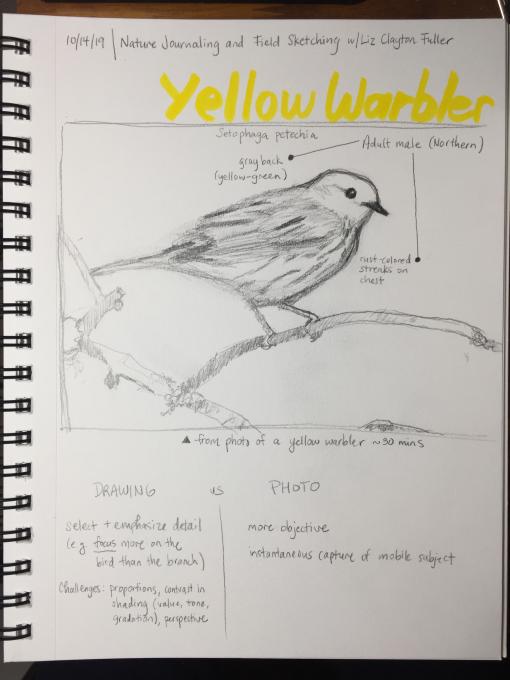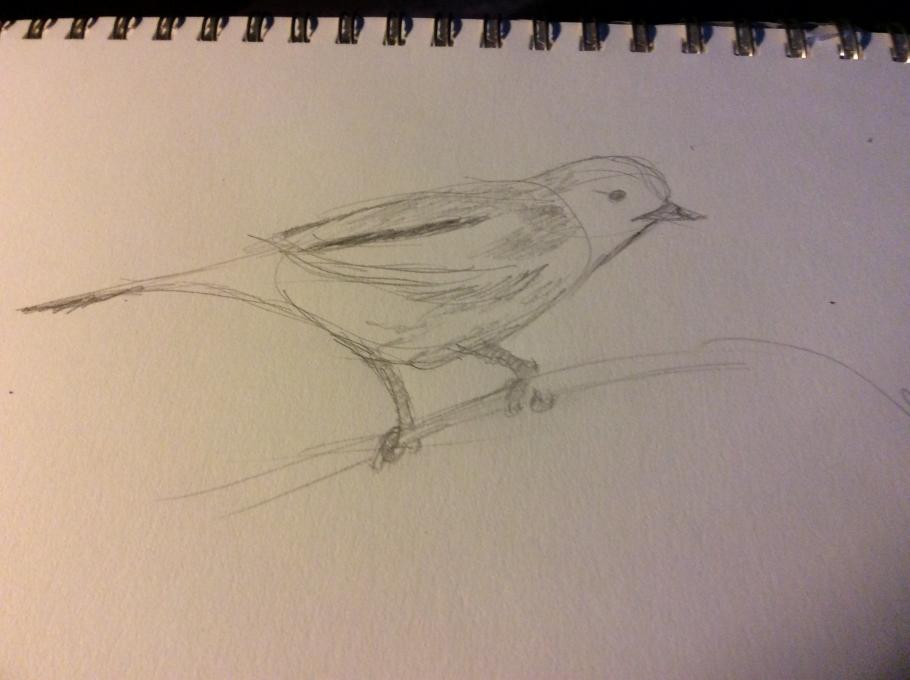The Cornell Lab Bird Academy › Discussion Groups › Nature Journaling and Field Sketching › Jump Right in!
-
I found that I enjoyed the process, but I expect it to be quick, and it is not. I also could not get the beak right. I used a hard lead pencil, and some colored pencils. I noticed the streaking a lot, and the way the cute little feet wrapped around the branch.

-
 1.) Wings and beak are difficult. I appreciated having the photo instead of a moving bird! It was difficult to get the proportions and shapes right and then to fit them together into a whole.
2.) I would not have noticed that the Yellow Warbler is actually dusky grey on the back or that the reddish marking extended up the throat. I have not observed either of these marks in the wild; I am usually overwhelmed by their yellowness.
1.) Wings and beak are difficult. I appreciated having the photo instead of a moving bird! It was difficult to get the proportions and shapes right and then to fit them together into a whole.
2.) I would not have noticed that the Yellow Warbler is actually dusky grey on the back or that the reddish marking extended up the throat. I have not observed either of these marks in the wild; I am usually overwhelmed by their yellowness. -
 1. I was nervous about drawing from the photo, but I was surprisingly happy with the result. The outline of the bird’s shape was easier than I thought it would be, and I found the feet to be the most challenging to draw.
2. Drawing the yellow warbler helped me to focus on the delicate bill shape and the patterns of its wings. I think having photos to refer to would be helpful in capturing details for nature journaling since birds are most often moving quickly in nature and often, for me, disappear before I can see or capture most of the details.
1. I was nervous about drawing from the photo, but I was surprisingly happy with the result. The outline of the bird’s shape was easier than I thought it would be, and I found the feet to be the most challenging to draw.
2. Drawing the yellow warbler helped me to focus on the delicate bill shape and the patterns of its wings. I think having photos to refer to would be helpful in capturing details for nature journaling since birds are most often moving quickly in nature and often, for me, disappear before I can see or capture most of the details. -
 Here is my first shot at the assigned drawing. I found working from a photo a relaxing way to start paying closer attention to detail and slowing down the whole process.
I figured out how to do the transfer on my iPhone.
This has been really enjoyable ! Love seeing everyone’s work on these posts.😊
mary ann
Here is my first shot at the assigned drawing. I found working from a photo a relaxing way to start paying closer attention to detail and slowing down the whole process.
I figured out how to do the transfer on my iPhone.
This has been really enjoyable ! Love seeing everyone’s work on these posts.😊
mary ann -
How can I post my photo of my drawing here.I am taking the pic of my work with an iPhone. Then wanting to transfer that photo to this reply "Inserting Image" Thanks, Mary Ann
-
Uploading Images of your art to the Discussion Boards. For those with smartphones or iPads:
- Take a digital photo of your artwork with your smart phone.
- Use the devices web browser (i.e. Safari or Chrome) to search for and then sign in to Bird Academy.
- Login to the Nature Journaling course right on your smart phone or iPad
- Click on "insert image" on the discussion board post and it will go to your devices camera roll and allow you to select the image to add to the post.
-
-
 So many impressive drawings and helpful comments - Thanks so much for sharing!
I liked drawing from the photo because I had the time to take into account the whole picture spatially as well as the details (even though my warbler came out too skinny this time : )
Also the photo helps one to better see details, by being able to zoom in closer and capture the image of the bird more discretely, than otherwise possible from a distance.
So many impressive drawings and helpful comments - Thanks so much for sharing!
I liked drawing from the photo because I had the time to take into account the whole picture spatially as well as the details (even though my warbler came out too skinny this time : )
Also the photo helps one to better see details, by being able to zoom in closer and capture the image of the bird more discretely, than otherwise possible from a distance. -
The whole exercise was challenging since my drawing experience is minimal. I can't say that any of it came easily! If I hadn't been drawing the photo, I wouldn't have noticed details like how the bird's feet clasp the branch, the dark and light areas on the leaves and branch, the details of the outline shape of the warbler. Here's my drawing. There's nowhere to go but up!

-
 1. Drawing from the photo was ok. It was easy to get the general idea sketched down. The bird and the branch and a bird shape. Getting the proportions right was a little difficult. I feel like my bird isnt as full. The picture is also really really detailed and its a challenge to capture that in the sketch.
2. Yes, the fine hairs/feathers that are whispy are noticeable when you are studying the detail. And each layer of feather is also something that I picked up on from the photo. This definitely makes a difference for nature journaling. I think the details and textures will matter.
1. Drawing from the photo was ok. It was easy to get the general idea sketched down. The bird and the branch and a bird shape. Getting the proportions right was a little difficult. I feel like my bird isnt as full. The picture is also really really detailed and its a challenge to capture that in the sketch.
2. Yes, the fine hairs/feathers that are whispy are noticeable when you are studying the detail. And each layer of feather is also something that I picked up on from the photo. This definitely makes a difference for nature journaling. I think the details and textures will matter.
-
 Advantage Drawing: I get a better understanding of the subject’s physiology, overall size and shape. By drawing it I can emphasis and focus on some the “Trade Mark”ings of the subject.
Advantage Photo: Stops Movement. Size and Shape are not disputable.
1. Drawing from the photo gave me time to complete my sketch. The angle of the Warbler was the biggest challenge (I felt).
2. The feet and their grip on the branch was interesting and I’m sure I would not have noticed that in the photo alone. Also, the emphasis surrounding the eye would have been lost for sure.
Louise
Advantage Drawing: I get a better understanding of the subject’s physiology, overall size and shape. By drawing it I can emphasis and focus on some the “Trade Mark”ings of the subject.
Advantage Photo: Stops Movement. Size and Shape are not disputable.
1. Drawing from the photo gave me time to complete my sketch. The angle of the Warbler was the biggest challenge (I felt).
2. The feet and their grip on the branch was interesting and I’m sure I would not have noticed that in the photo alone. Also, the emphasis surrounding the eye would have been lost for sure.
Louise -
I enjoyed this activity. I thought the positioning of everything was the most difficult. I also wish I would have added color. The shading on the tree and some of the bird is also difficult to capture. Sorry if this shows up twice I submitted an answer previous but didn't see the submission. I would not have noticed the nostril or the membrane on the beak if I wasn't asked to draw it. Additionally, I would have missed all the Lichens.

-
1) I have not drawn anything since high school--about 50 years ago. I enjoyed my art classes then. So, drawing from the photo brought back a lot of those memories. I remembered how much better I got when I drew every day--that kept me encouraged. I think it would have been frustrating otherwise. Drawing perspective to make the bird look three-dimensional was challenging. Drawing the relative sizes of the bird's body parts (bill, head, eye, wings, etc) was easier than drawing the perspective. 2)The leaves look as though they have been eaten--I wouldn't have noticed it without drawing them. This might be important for information about the bird's environment. Does the bird eat the insects that eat the leaves? It made me want to ask more questions about the photo--what time of year is this? Is the bird migrating? Drawing the photo made me notice field markings for the bird--no eye ring, the color of the legs, the amount and color of the streaking on the breast,etc. This would be helpful if I were trying to identify the bird in the field.
-
I'm retired, and haven't drawn anything of note since elementary school. I enjoyed taking the time to notice fine details in the image, and I found the process meditative. My pencil drawing was okay, had trouble adding the watercolors. Look forward to learning some techniques to improve the drawing and colors. I love seeing all your different examples. Nice work!
-
 As mentioned by others, having the photo meant the bird kept still and I had time to see details. After reading other comments I realize that I was. Outing and trying to draw the details of each feather without noticing the general character of clusters of feathers.
getting the initial shape was hard. My poor bird was anorexic at first.
As mentioned by others, having the photo meant the bird kept still and I had time to see details. After reading other comments I realize that I was. Outing and trying to draw the details of each feather without noticing the general character of clusters of feathers.
getting the initial shape was hard. My poor bird was anorexic at first. -
Drawing from a photos is within my comfort zone. I’ve drawn birds before so the outline is less of a challenge. Branches and leaves on the other hand are a lot harder photos are useful to see all details when zoomed in. Also the subject matter stays in the same pose so you can take your time.

-
Getting the basic shape and proportions wasn't too hard. (I've drawn birds from photos before.) Getting the feathering right without it looking stilted was almost impossible, and I have a tendency to do everything in a very sketchy manner. I would like to address this during the course. I wouldn't have noticed the other toes on the feet curling around from the back of the branch if I hadn't been drawing it. I'm not happy with the way I did the wings and how the feet emerge from the body. It will be fun to sit down another time and make a good, detailed drawing.

-
1. Drawing from the photo gave me lots of time to mess around on the page, maybe too much time because there is a lot to see on one little bird. The basic sketch was easier than I thought it would be so I was surprised and happy with how that turned out. Once I decided to color it I felt like I was ruining it. My bird looks more like a thrush than a warbler. Oh well first try! 2. I wouldn't have studied this photo as intensely if I wasn't drawing it. I really got into the feathers. I love feathers, they are so beautiful. I really want to play around with sketching and painting feathers. On this warbler the yellow feathers above the legs are so wispy and the scallop pattern on the wings and tail are super intricate. The feathers really produce the shape and attitude of the bird. It's hard to reproduce that. The drawing flattens the warbler. I hope to learn how to put some personality into the subject by making those feathers fluff out on the page.

-
I found the suggestion to think of the bird as a series of connected shapes (ovals in this case) to be helpful for getting the proportions right. I enjoyed trying to capture his personality.

-
You captured the proportions and the wing feathers so well. Truly a beautiful drawing.
-
-
SO much fun looking at everyone's wonderful drawings. :-)
-
1. It was nice having the subject not move! In fact, I started it on the 7th and then had company and didn't finish it until today, the 15th! It was challenging to capture everything I saw with pencil only. Decided not to try color yet since I am totally new at this. Also was challenging to not keep fussing with it. 2. I really noticed everything going on with the branch, with all the texture and lichen. Also the different colors and patterns in the bird's feathers. And the irregularities in the leaves--chewed areas, brown spots, etc.

-
Hi folks! Got a bit of a late start to the course but I finally got around to it. Actually putting to paper was tough, but once I set out do it without overthinking it got easier. I found getting the placement of different elements was a challenge. Where does the beak go? How low is the eye? How far back are the legs? Translating a whole image into small details felt really hard, but I felt like it started to come together the less I tried to make it perfect. I definitely would not have noticed the exact colors present on the bird from a photograph alone. Paying attention to those details will be important in accurately representing what's being sketched.

-
Don't worry. There is no such thing as "late" in this course as new people are buying it and/or starting it every day. This is totally go at your own pace. Take your time everyone. Some people might finish quickly and others might take years. There will always be someone starting or doing an assignment after you. I hope that makes everyone feel better and not worry that they are behind as there is no such thing in this course. Thanks for posting your "Before" drawing. :-)
-
@Lee Ann van Leer This is a silly question How do I send you my picture? Lee Ann Wille
-
-
1. How did you feel about drawing from the photo? What came easily and what was challenging? I have drawn from photos before and found I made my customary mistakes of making the feet and head too large and consequently spent far too long reworking the image, a luxury I would not have had I been drawing from life. I’ve never added ink or watercolour to a drawing before, and I found that far more challenging than I’d anticipated. I couldn’t create the colours I wanted, I lost all my details and shading and struggled to embrace the free-flowing nature of watercolours. The end result feels both garish and flat - room for improvement! 2. Was there anything in the photo that you might not have noticed if you weren’t asked to draw it? Would this make a difference when nature journaling? I almost certainly would not have noticed the details of the branches or those of the primaries and secondaries or the olive-grey hues of the mantle.

-
Hi all! Well did the first assignment and found it very difficult. Good thing the bird couldn't move because it took me way too long to do not so much. I'm very much enjoying this class and can't wait to learn some tips and techniques to become more selective and accurate in capturing nature.

-
This first drawing went better than I thought it would; I think there may be hope for my nature journaling! I found the different types of feathers to be probably the most difficult part. Figuring out how to represent the detail on the branch was tricky too though! There are so many details I wouldnt have noticed if I had just taken a photo: the reddish streaks on the breast of the bird, the olive back, and all the different kinds of growths
 on the branches. I love that when you look closely, what looks like a simple branch actually has a lot more going on!
on the branches. I love that when you look closely, what looks like a simple branch actually has a lot more going on! -
I would not have noticed the gray back (the All About Birds ID guide says yellow-green) or the streaked breast on this yellow warbler if I had not taken the time to draw from the photo. With the color photo, I tend to gloss over the nuances and see just yellow. With the pencil sketch, I can more easily point out the different colorings and markings and use these color patterns to not only confirm the ID of Yellow Warbler but the region, age, and sex (Northern adult male) as well. This explains why I prefer field guides that illustrate with drawings rather than photographs.

-
Well, it does resemble a bird. I love the photo holding still while I drew. Drawing a subject does allow you to ignore the rest of the scene, that is a plus sometimes.

Read More:
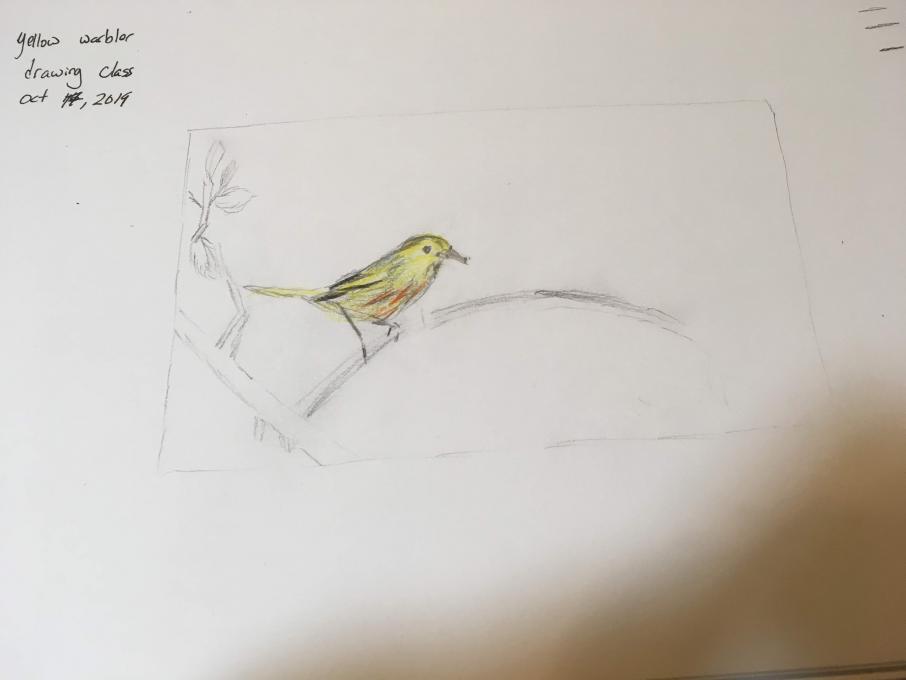
 1.) Wings and beak are difficult. I appreciated having the photo instead of a moving bird! It was difficult to get the proportions and shapes right and then to fit them together into a whole.
2.) I would not have noticed that the Yellow Warbler is actually dusky grey on the back or that the reddish marking extended up the throat. I have not observed either of these marks in the wild; I am usually overwhelmed by their yellowness.
1.) Wings and beak are difficult. I appreciated having the photo instead of a moving bird! It was difficult to get the proportions and shapes right and then to fit them together into a whole.
2.) I would not have noticed that the Yellow Warbler is actually dusky grey on the back or that the reddish marking extended up the throat. I have not observed either of these marks in the wild; I am usually overwhelmed by their yellowness. 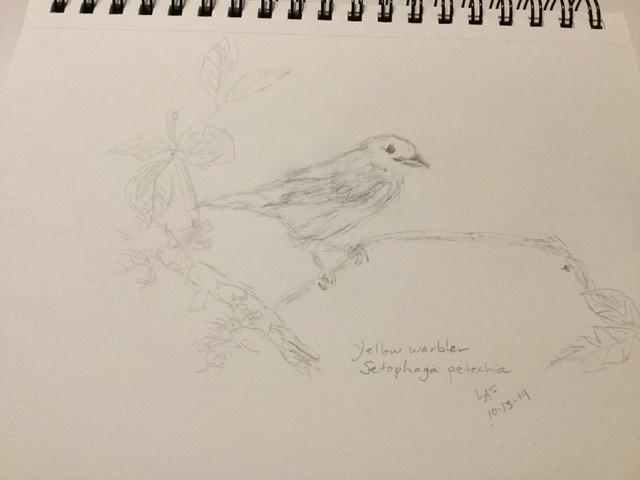 1. I was nervous about drawing from the photo, but I was surprisingly happy with the result. The outline of the bird’s shape was easier than I thought it would be, and I found the feet to be the most challenging to draw.
2. Drawing the yellow warbler helped me to focus on the delicate bill shape and the patterns of its wings. I think having photos to refer to would be helpful in capturing details for nature journaling since birds are most often moving quickly in nature and often, for me, disappear before I can see or capture most of the details.
1. I was nervous about drawing from the photo, but I was surprisingly happy with the result. The outline of the bird’s shape was easier than I thought it would be, and I found the feet to be the most challenging to draw.
2. Drawing the yellow warbler helped me to focus on the delicate bill shape and the patterns of its wings. I think having photos to refer to would be helpful in capturing details for nature journaling since birds are most often moving quickly in nature and often, for me, disappear before I can see or capture most of the details. 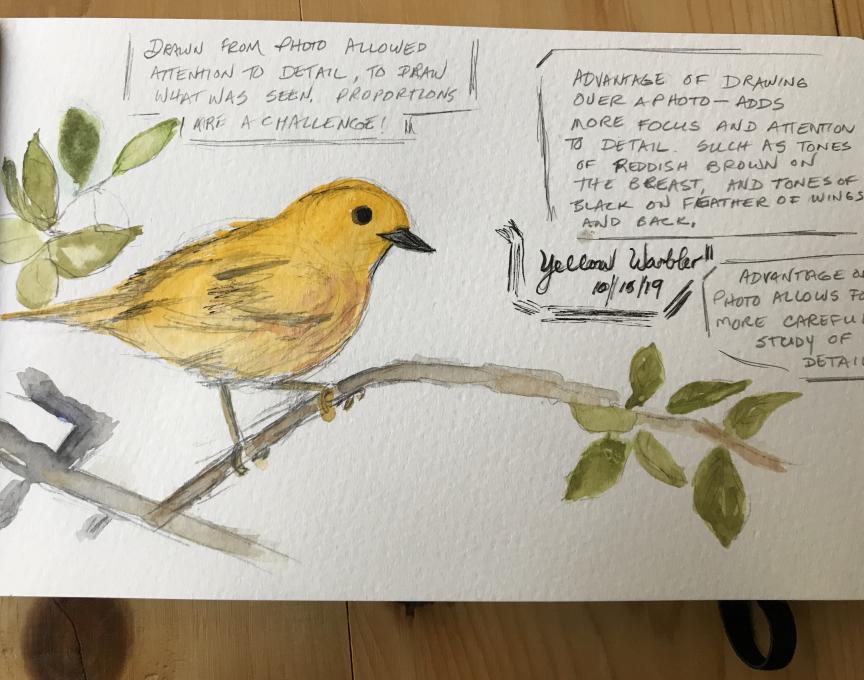 Here is my first shot at the assigned drawing. I found working from a photo a relaxing way to start paying closer attention to detail and slowing down the whole process.
I figured out how to do the transfer on my iPhone.
This has been really enjoyable ! Love seeing everyone’s work on these posts.😊
mary ann
Here is my first shot at the assigned drawing. I found working from a photo a relaxing way to start paying closer attention to detail and slowing down the whole process.
I figured out how to do the transfer on my iPhone.
This has been really enjoyable ! Love seeing everyone’s work on these posts.😊
mary ann  So many impressive drawings and helpful comments - Thanks so much for sharing!
I liked drawing from the photo because I had the time to take into account the whole picture spatially as well as the details (even though my warbler came out too skinny this time : )
Also the photo helps one to better see details, by being able to zoom in closer and capture the image of the bird more discretely, than otherwise possible from a distance.
So many impressive drawings and helpful comments - Thanks so much for sharing!
I liked drawing from the photo because I had the time to take into account the whole picture spatially as well as the details (even though my warbler came out too skinny this time : )
Also the photo helps one to better see details, by being able to zoom in closer and capture the image of the bird more discretely, than otherwise possible from a distance. 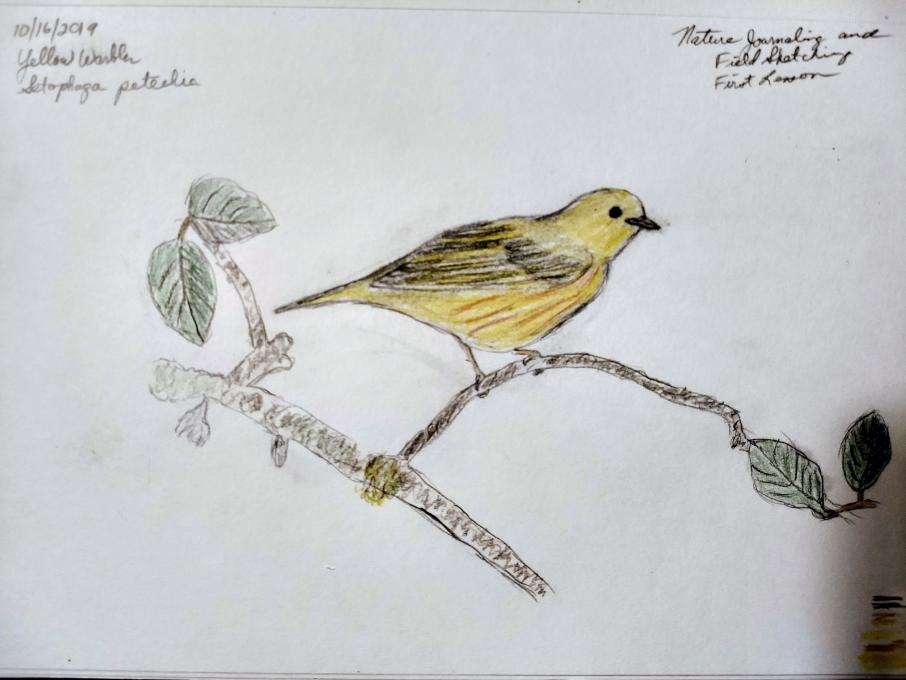
 1. Drawing from the photo was ok. It was easy to get the general idea sketched down. The bird and the branch and a bird shape. Getting the proportions right was a little difficult. I feel like my bird isnt as full. The picture is also really really detailed and its a challenge to capture that in the sketch.
2. Yes, the fine hairs/feathers that are whispy are noticeable when you are studying the detail. And each layer of feather is also something that I picked up on from the photo. This definitely makes a difference for nature journaling. I think the details and textures will matter.
1. Drawing from the photo was ok. It was easy to get the general idea sketched down. The bird and the branch and a bird shape. Getting the proportions right was a little difficult. I feel like my bird isnt as full. The picture is also really really detailed and its a challenge to capture that in the sketch.
2. Yes, the fine hairs/feathers that are whispy are noticeable when you are studying the detail. And each layer of feather is also something that I picked up on from the photo. This definitely makes a difference for nature journaling. I think the details and textures will matter.
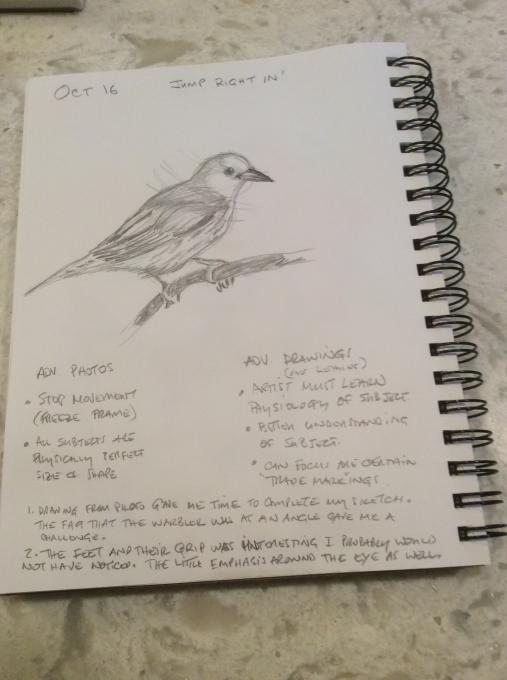 Advantage Drawing: I get a better understanding of the subject’s physiology, overall size and shape. By drawing it I can emphasis and focus on some the “Trade Mark”ings of the subject.
Advantage Photo: Stops Movement. Size and Shape are not disputable.
1. Drawing from the photo gave me time to complete my sketch. The angle of the Warbler was the biggest challenge (I felt).
2. The feet and their grip on the branch was interesting and I’m sure I would not have noticed that in the photo alone. Also, the emphasis surrounding the eye would have been lost for sure.
Louise
Advantage Drawing: I get a better understanding of the subject’s physiology, overall size and shape. By drawing it I can emphasis and focus on some the “Trade Mark”ings of the subject.
Advantage Photo: Stops Movement. Size and Shape are not disputable.
1. Drawing from the photo gave me time to complete my sketch. The angle of the Warbler was the biggest challenge (I felt).
2. The feet and their grip on the branch was interesting and I’m sure I would not have noticed that in the photo alone. Also, the emphasis surrounding the eye would have been lost for sure.
Louise 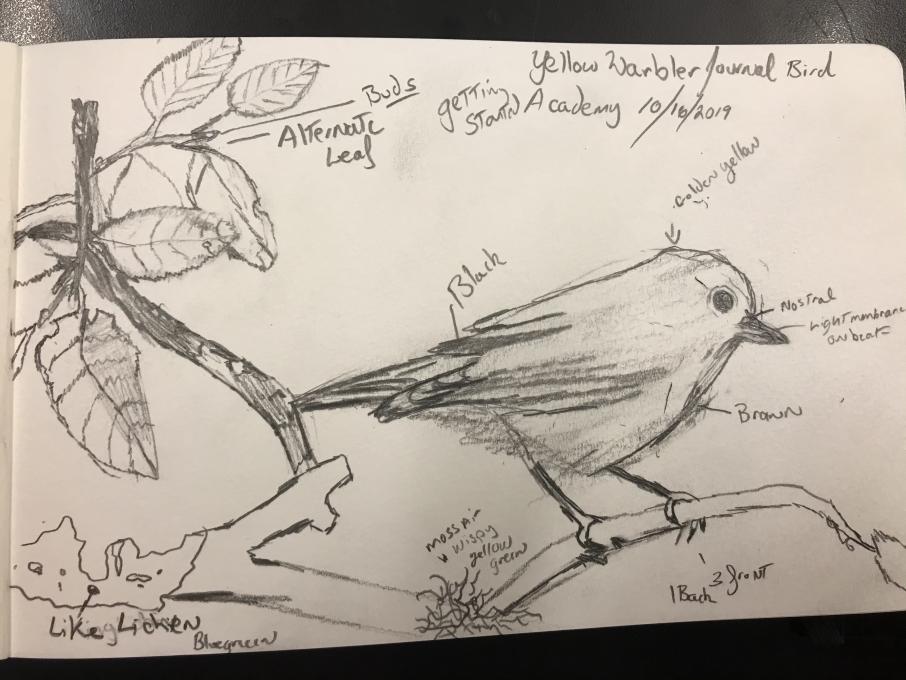
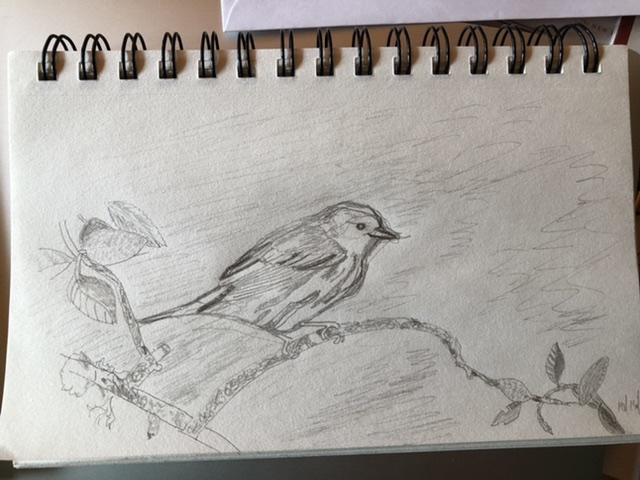 As mentioned by others, having the photo meant the bird kept still and I had time to see details. After reading other comments I realize that I was. Outing and trying to draw the details of each feather without noticing the general character of clusters of feathers.
getting the initial shape was hard. My poor bird was anorexic at first.
As mentioned by others, having the photo meant the bird kept still and I had time to see details. After reading other comments I realize that I was. Outing and trying to draw the details of each feather without noticing the general character of clusters of feathers.
getting the initial shape was hard. My poor bird was anorexic at first. 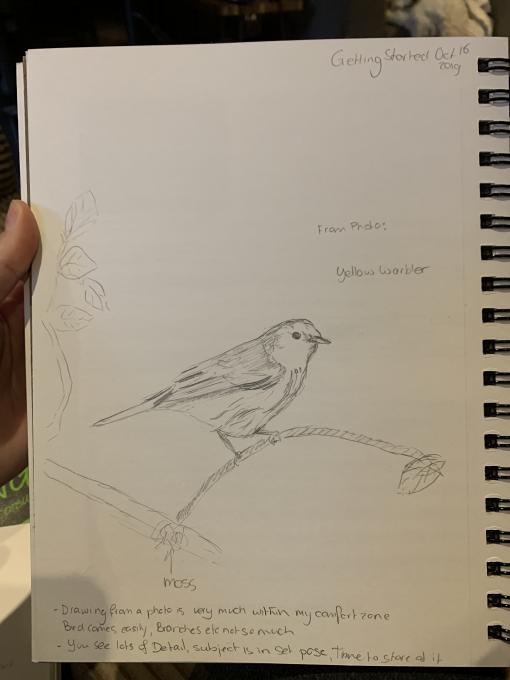
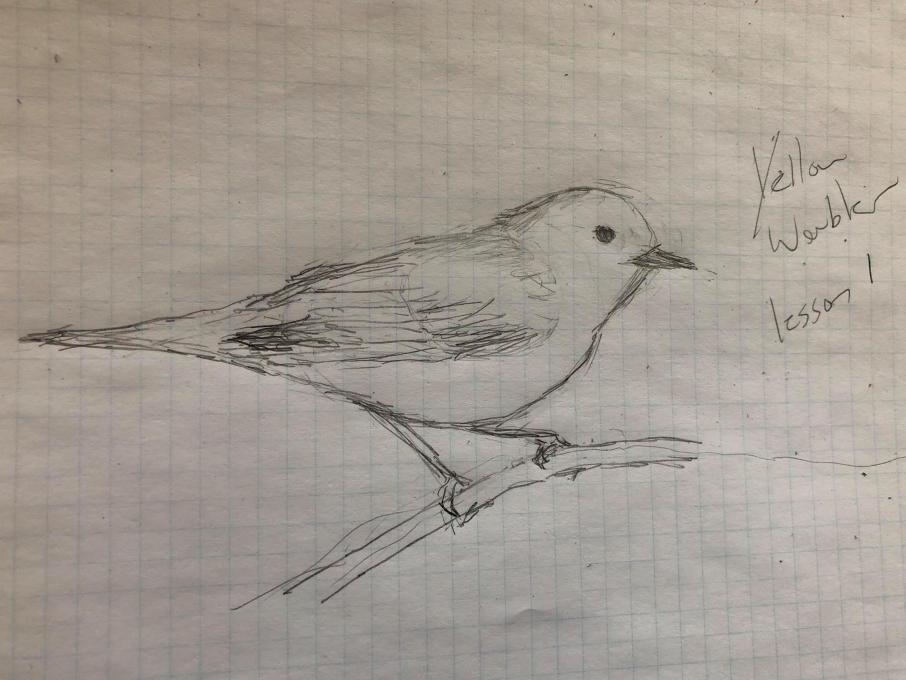
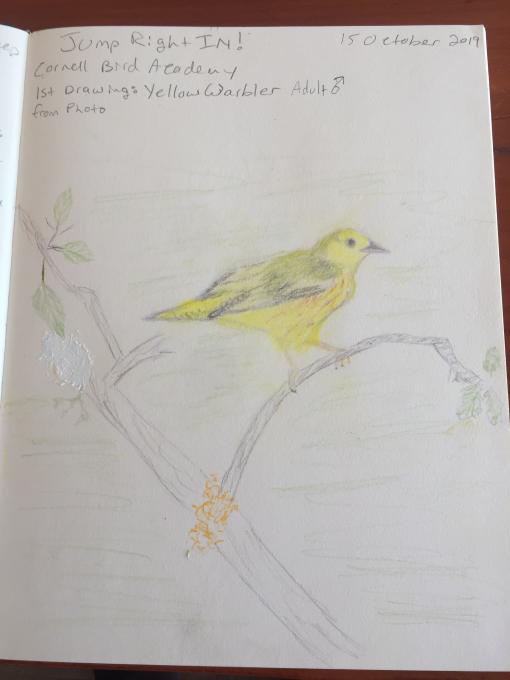
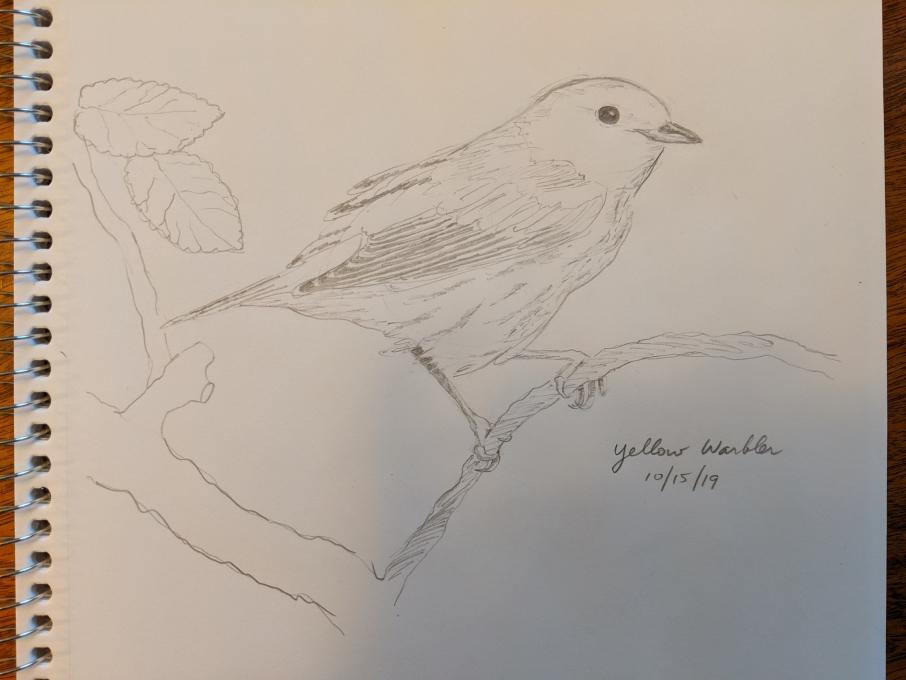

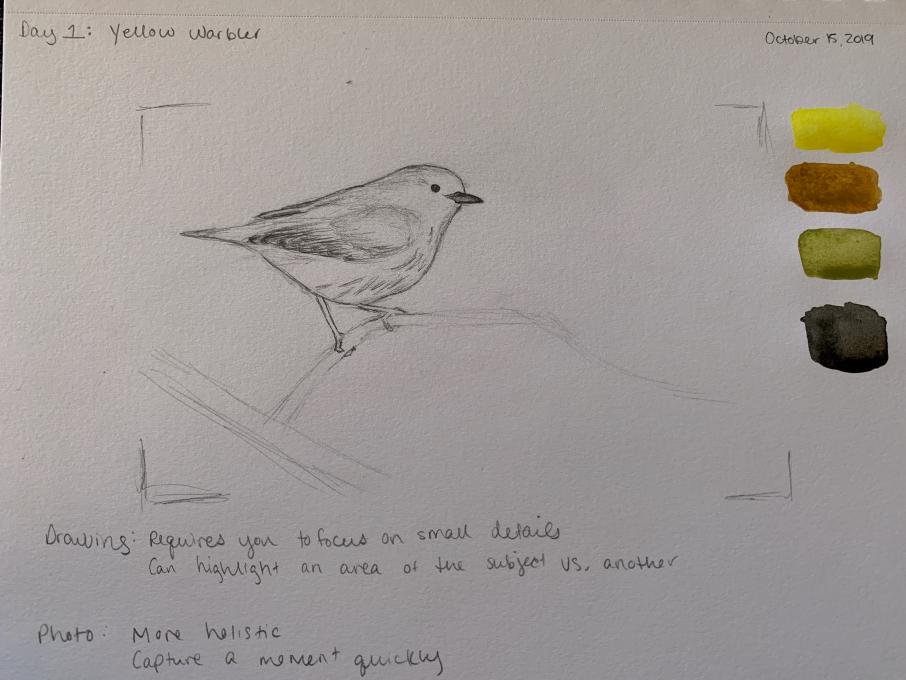
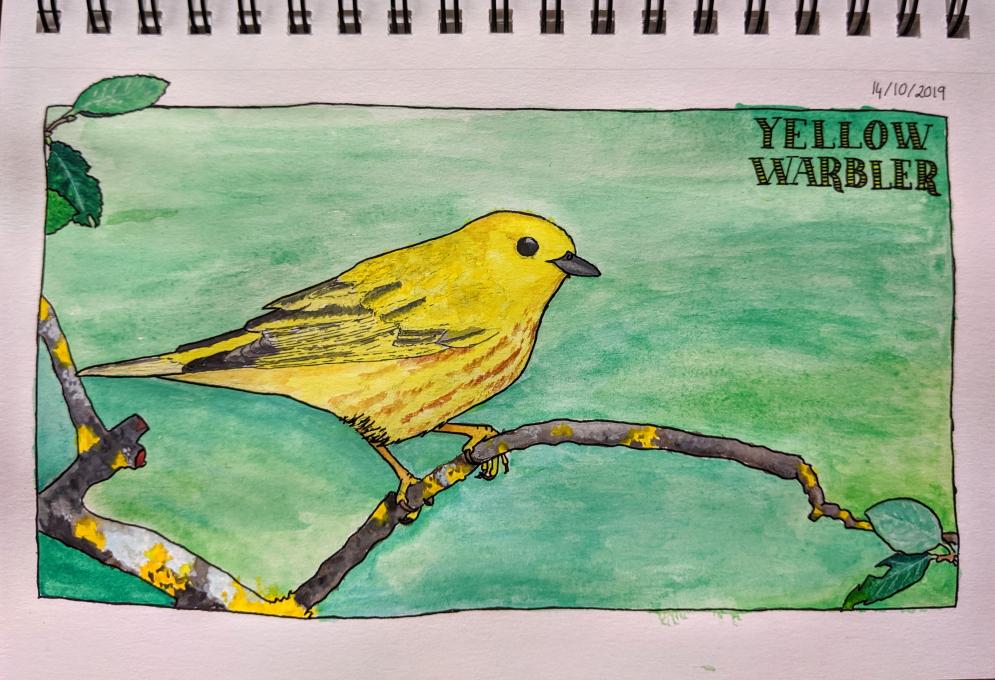
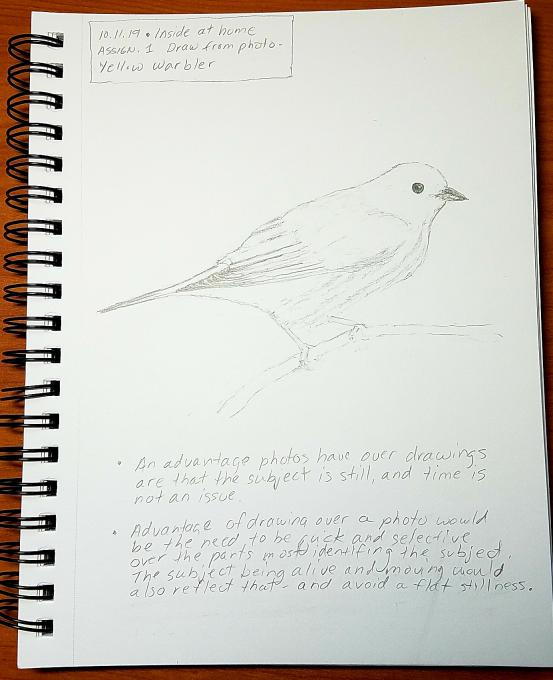
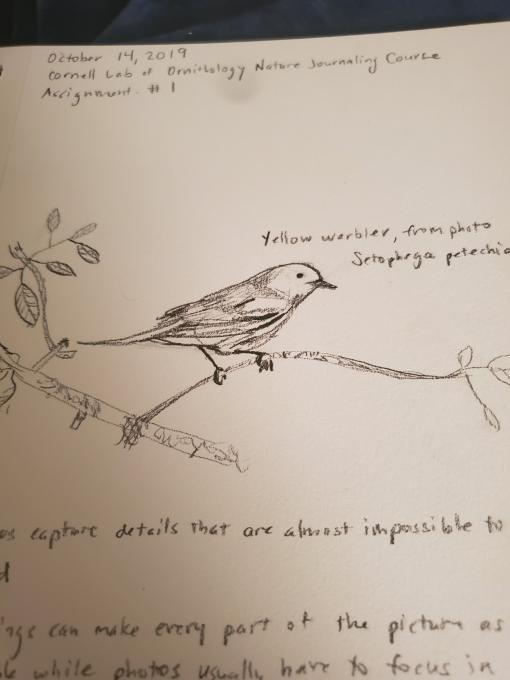 on the branches. I love that when you look closely, what looks like a simple branch actually has a lot more going on!
on the branches. I love that when you look closely, what looks like a simple branch actually has a lot more going on! 